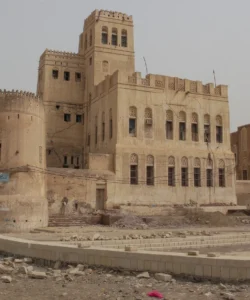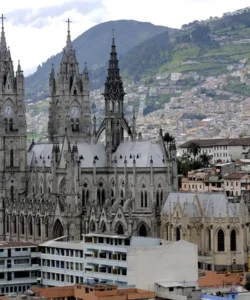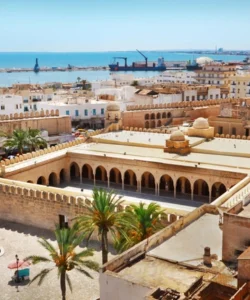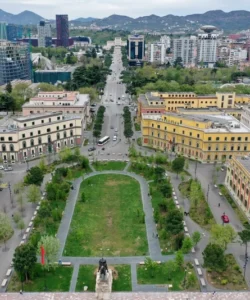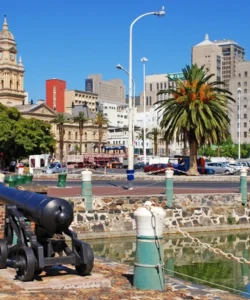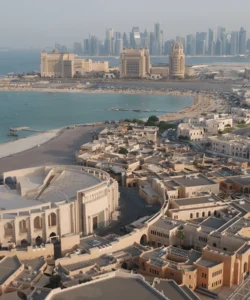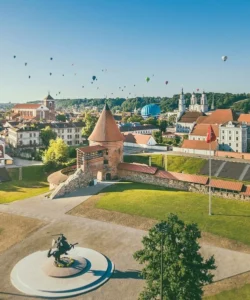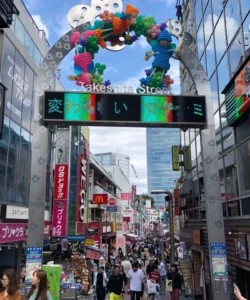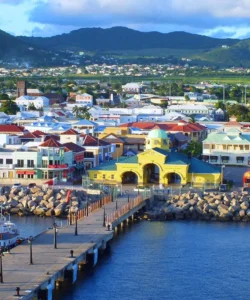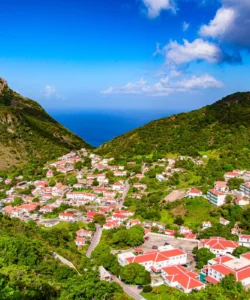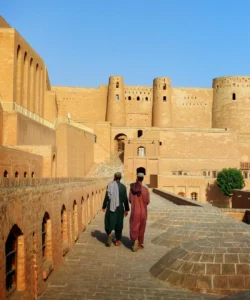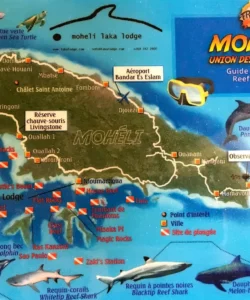Puerto Rico, officially the Commonwealth of Puerto Rico, is an unincorporated territory of the United States located in the northeastern Caribbean Sea. Known as “La Isla del Encanto” (The Island of Enchantment), it offers a vibrant blend of Spanish, Taíno, and African cultures, stunning natural beauty, and a rich history.
![]()
Area and Population:
Puerto Rico consists of the main island of Puerto Rico and several smaller islands, including Vieques, Culebra, and Mona. The total land area is approximately 9,104 sq. km (3,515 sq. mi). As of 2024, the estimated population is around 3.2 million people.
Language:
The official languages are Spanish and English. Spanish is the primary language spoken by the majority of the population, while English is widely understood, especially in metropolitan areas and tourist zones.
Currency:
The official currency is the United States Dollar (USD).
Religion:
The predominant religion is Roman Catholicism, reflecting its Spanish heritage. Various Protestant denominations are also present.
Capital:
The capital city of Puerto Rico is San Juan. It is the largest city on the island and a major port and cultural center.
Major Cities/Towns:
Besides San Juan, other significant cities and towns include Ponce (known for its unique architecture), Mayagüez, Carolina, Caguas, and Fajardo (a gateway to the eastern islands).
Attractions:
Puerto Rico offers a diverse range of attractions, from historical sites to natural wonders:
- Old San Juan (Viejo San Juan): A UNESCO World Heritage site, this historic district is famous for its colorful colonial buildings, cobblestone streets, and impressive fortifications.
- El Morro (Castillo San Felipe del Morro): A majestic 16th-century citadel perched on a promontory, offering panoramic ocean views and a deep dive into military history.
- San Cristóbal (Castillo de San Cristóbal): A massive 18th-century fortress, part of San Juan’s extensive defense system.
- La Fortaleza: The governor’s official residence, also a UNESCO site and the oldest executive mansion in continuous use in the Americas.
- El Yunque National Forest: The only tropical rainforest in the U.S. National Forest System. It boasts lush greenery, diverse wildlife, numerous hiking trails, and cascading waterfalls (like La Mina Falls and Juan Diego Falls).
- Bioluminescent Bays (Bio Bays): Puerto Rico is home to three of the world’s few bioluminescent bays, where microscopic organisms create a magical glow in the water at night. Mosquito Bay in Vieques is considered the brightest, followed by Laguna Grande in Fajardo and La Parguera in Lajas.
- Flamenco Beach (Culebra): Often ranked among the world’s most beautiful beaches, known for its pristine white sand, calm turquoise waters, and unique abandoned tanks from military exercises.
- Ponce: The “Pearl of the South,” known for its unique architecture (including the Parque de Bombas and Casa Armstrong-Poventud), art museums (Museo de Arte de Ponce), and charming plazas.
- Culebra & Vieques: Smaller islands accessible by ferry or small plane, offering a more laid-back vibe, stunning beaches, and opportunities for snorkeling and diving.
- Camuy River Cave Park (Parque de las Cavernas del Río Camuy): One of the largest cave systems in the world, featuring immense caverns and an underground river.
- Toro Verde Urban Park (Orocovis): Home to “The Monster,” one of the longest zip lines in the world.
Natural Wonders:
Puerto Rico’s diverse geography includes:
- Rainforests: El Yunque stands as a unique tropical rainforest.
- Karst Topography: Characterized by sinkholes and vast cave systems (like Río Camuy).
- Bioluminescent Bays: A rare and spectacular natural phenomenon.
- Mountains: The central mountain range (Cordillera Central) includes Cerro de Punta, the highest peak.
- Beaches: Diverse coastline with white, golden, and even black sand beaches.
Architecture:
Puerto Rican architecture is a fascinating blend of historical styles and adaptations to the tropical environment:
- Spanish Colonial (Old San Juan): Characterized by cobblestone streets, colorful two-story buildings with balconies, inner courtyards (patios), red-tiled roofs, and strong defensive fortifications.
- Art Deco & Beaux-Arts (Santurce, Ponce): Many buildings in the early to mid-20th century incorporated these styles, particularly in commercial and public structures.
- Neo-Classical (Ponce): Evident in public buildings and some residences in Ponce.
- Modern Tropical: Contemporary designs for homes and resorts often incorporate open layouts, natural ventilation, and integration with the landscape.
Roads:
Puerto Rico has an extensive network of roads, including well-maintained highways (expresos) that connect major cities, and secondary roads that can be more winding and less maintained, especially in mountainous regions. Driving is on the right-hand side of the road. While generally good, traffic can be heavy in metropolitan areas like San Juan, and signage can be in Spanish. Toll roads are common on highways.
Hotels:
Puerto Rico offers a wide range of accommodation options, from large international chain resorts and boutique hotels to charming guesthouses and Airbnb rentals.
- The Ritz-Carlton, San Juan (currently closed for renovation/reimagining, but a past prominent luxury option)
- Condado Vanderbilt Hotel (San Juan): A historic luxury hotel on the Condado beachfront.
- El Conquistador Resort, A Waldorf Astoria Resort (Fajardo): A sprawling resort with multiple pools, a water park, and a private island.
- Caribe Hilton (San Juan): A historic oceanfront resort credited with inventing the Piña Colada.
- Hyatt Regency Grand Reserve Puerto Rico (Rio Grande): A large beachfront resort with a golf course.
- Dorado Beach, a Ritz-Carlton Reserve (Dorado): An ultra-luxury, exclusive resort.
- Numerous boutique hotels in Old San Juan.
Restaurants:
Puerto Rico’s culinary scene is a vibrant fusion of Taíno, Spanish, and African influences, known as Cocina Criolla. Dining options range from upscale fine dining to casual roadside kiosks (chinchorros) and food trucks.
- Marmalade Restaurant & Wine Bar (Old San Juan): An acclaimed fine-dining restaurant known for its tasting menus and innovative cuisine.
- José Enrique (Santurce): A popular spot for authentic Puerto Rican cuisine with a fresh, modern twist.
- La Fonda del Jibarito (Old San Juan): Offers traditional, hearty Puerto Rican comfort food in a casual setting.
- Santaella (Santurce): A stylish restaurant offering contemporary Puerto Rican and Latin American dishes.
- Pinones (Loíza): A strip of casual beachfront kiosks serving fried seafood, alcapurrias, and other local specialties.
- La Casita Blanca (Santurce): Known for its authentic, home-style Puerto Rican food and charming, rustic ambiance.
Cuisine:
Puerto Rican cuisine is a rich, flavorful blend, often characterized by its use of sofrito (a fragrant base of aromatic vegetables) and a balance of savory, sweet, and tangy notes.
- Mofongo: The unofficial national dish, made from fried green plantains mashed with garlic, olive oil, and pork cracklings (chicharrón), often served with various meats or seafood in a broth.
- Arroz con Gandules: Rice with pigeon peas, a staple dish, especially popular during holidays.
- Lechón Asado: Spit-roasted whole suckling pig, a beloved festive dish, known for its crispy skin.
- Pasteles: Similar to tamales, made from grated green plantains or root vegetables, stuffed with meat, and wrapped in banana leaves before boiling.
- Alcapurrias: Fried fritters made from a masa of green plantains and yautía (taro), filled with ground meat or crab.
- Empanadillas (or Pastelillos): Fried turnovers with savory fillings (meat, cheese, seafood).
- Asopao: A hearty, soupy rice dish with chicken, seafood, or pork.
- Tostones: Twice-fried green plantains, often served as a side.
- Coquito: A traditional Christmas drink similar to eggnog, made with coconut milk, rum, and spices.
- Piña Colada: The official drink of Puerto Rico, a sweet cocktail made with rum, cream of coconut, and pineapple juice.
- Fresh Tropical Fruits: Abundant and used in juices, desserts, and dishes.







































